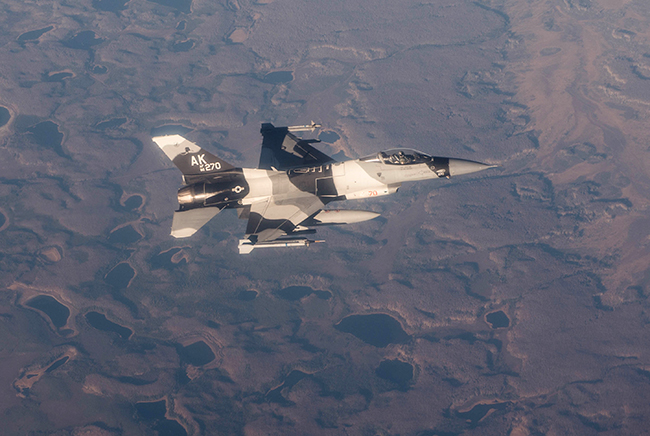
USAF Capt. Todd Possemato, an 18th Aggressor Squadron pilot, flies an F-16 Fighting Falcon aircraft on Oct. 12, 2016, over the Joint Pacific Alaska Range Complex during RED FLAG-Alaska 17-1 at Eielson AFB, Alaska. Air Force photo by SSgt. Shawn Nickel.
Military training ranges in the Pacific are severely limited in how they can train pilots and need to be upgraded as the military brings in new aircraft, the Defense Department Inspector General states in a recent report.
The IG reviewed US Indo-Pacific Command ranges in Japan, South Korea, Hawaii, Alaska, Nevada, and Arizona, and found “training ranges and airspace” appeared stuck on World War II and Cold War-era mission needs, and “did not have the capability or capacity to support aviation readiness for units assigned” to the command. Training land, airspace, impact areas, and electronic warfare systems were limited.
The Joint Pacific Alaska Range Complex, which is heavily used by Air Force units in the region, for example, does not have modern electronic warfare systems, “which limited the training that pilots received,” the report states. Additionally, the Air Force and Army don’t have a clear command structure to operate this range. Ranges in Japan and Korea also are limited because US aircraft have to share them with host nation forces.
Aircrews “could not train as they would fight, which the National Defense Strategy states is essential for lethality and success in accomplishing theater campaign and operation plan objectives,” the report states.
Going forward, the IG recommends the Pentagon review the individual services’ range plans, and determine whether these solutions can be accomplished throughout the department. Additionally, the Pentagon should develop and implement a plan to field and sustain DOD-wide solutions to address training gaps, including finding ways to better train advanced aircraft.
Improving ranges and the ability to implement live, virtual, and constructive training has long been a push for Pacific Air Forces and INDOPACOM. PACAF Commander Gen. Charles Q. Brown said in September that improvements to the Alaska range is needed to “push the envelope” on how pilots can exercise. Recent budgets include funding for new capabilities, such as improved threat emulators, targets, and decoys.
In a March interview with Air Force Magazine, Brown said additional virtual constructive capability is a necessity because “it’s going to be hard to replicate all the things we want to see.” Virtual capabilities are ways to “actually improve the level of training, so that’s an area that we have to take a serious look at.”